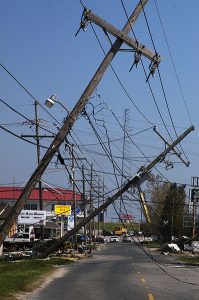
Guest Author: Printus LeBlanc
Earlier this month, conservatives and budget hawks lost the fiscal battle to fund the military without raising domestic spending. The Senate cut a deal to increase domestic spending for the next two years by $131 billion and raise the budget caps on defense spending by $80 billion in fiscal year 2018 and $85 billion in fiscal year 2019.
This battle is over, and it is time to move on to the next one, what to do with the $131 billion. Democrats will want to add the two-year increase in spending to the baseline budget, thereby making the increases permanent. Republicans must make sure that does not happen and if the money is going to be spent, instead appropriate the money to one-time non-baseline budget projects. The weakness of the U.S. electric grid is one such item, the perfect project to spend the money on.
The U.S. is a society wholly dependent on electricity to survive. Water is pumped into your homes by electricity. Vehicles may run on gas, but the gas gets to the vehicles via pump powered by electricity. The food in the local supermarket is kept cool, transported, and produced with electricity. Without it, tens of millions would die.
The U.S. electric grid is composed of three smaller grids, one east of the Rocky Mountains, one west of the Rocky Mountains, and one in Texas. Each of these grids is composed of three elements, power generation, power transmission, and power distribution. It is no secret there are weak points in the system. Congress even put out a report outlining what it believed was the most dangerous scenario in 2008.
Electricity is starts at a power plant. It can be coal fired, natural gas, nuclear, or a windmill. From there the electricity flows to a High-Voltage Transformer (HVT). The HVT will “step-up” the electricity so it can be transported long distances via high voltage power lines. From the high voltage power lines, the electricity flows into another HVT where it is “stepped-down.” This is a critical process because homes and businesses cannot handle the higher-level voltage used to transport electricity. After the electricity flows through the second HVT, it is transmitted via local powerlines to the end user.
As you can see, the process of getting electricity from the point of production to the end user would be impossible without HVTs, and the problem gets worse from there. Producing an HVT is a time consuming and expensive endeavor. The Department of Energy estimated it can take up to 20 months to make the larger HTVs, while costing millions. After it is produced, transporting the HVT is another adventure. The larger devices can weigh up to 400 tons and need specially designed rail cars to move via railroad. Once they are on the road, it can be even more challenging to move the house sized objects though cities to the substations.
The final problem with HVTs is they are made for specific locations in the electric grid. Because the electric grid is made up of hundreds of smaller utilities, within the three main grids, there is no uniformity. An HVT for a coal plant outside of Mobile, AL might not work for natural gas plant near Houston, TX. This hampers the ability to interchange parts during an emergency.
The HVTs are vulnerable to four types of attacks:
- EMP- An Electromagnetic Pulse is generated as a result of a nuclear bomb. It is a burst of electromagnetic energy that damages electrical equipment, such as the Supervisory Control and Data Acquisition (SCADA) systems regulating the voltage in HVTs. If the SCADA systems go down, the HVTs go down.
- CME- The sun is perhaps the most dangerous adversary of the electric grid. A Coronal Mass Ejection from the Sun would have the same effect as an EMP, but on a global scale. A CME is an ejection of particles from the sun, also known as a solar flare. These happen quite often. The last major CME event to hit the Earth was in 1859. When it hit, there were reports of sparks shooting off telegraph wires in telegraph stations. A CME event today could shut down electronic devices worldwide.
- Cyber- As we saw with Stuxnet, SCADA systems are vulnerable to cyber-attacks. Attacking the SCADA systems that run the electric grid could cause severe physical damage and shutdown significant portions of the system.
- Physical- Since 2013 there have been two attacks on electric substations. One in Metcalf, California and another in rural Utah. In both attacks the HVTs were targeted with rifles and caused temporary shutdowns.
- I’d add weather to this. ~Kelly

Clearly the electric grid is the most important of the sixteen infrastructure sectors the Department of Homeland Security declared critical. Without electricity the banking system fails, without electricity the healthcare industry becomes non-existent, and without electricity there is no way to pump water to homes and businesses.
The fight about whether or not to spend the money is over, and we lost that fight. The fight now must be about spending it on one-time projects that are not added to the baseline budget in the future. We can choose to spend the money on needed projects, or we can let the bureaucrats make that decision for us. If we’re going to spend the money anyway, Congress should include protecting the electric grid as a one-time project in the upcoming budget as part of the increased domestic spending.
Printus LeBlanc is a contributing editor at Americans for Limited Government.
Image: By Liz Roll (This image is from the FEMA Photo Library.) [Public domain], via Wikimedia Commons
